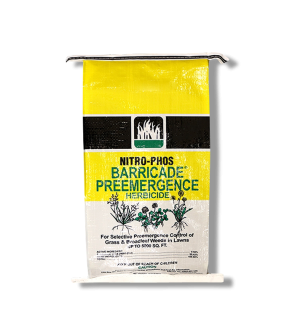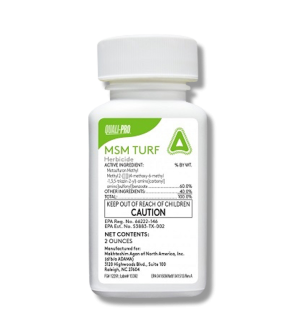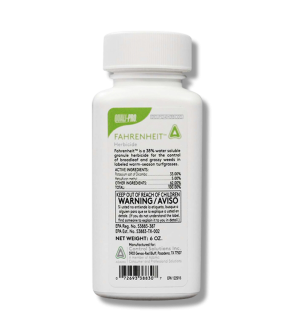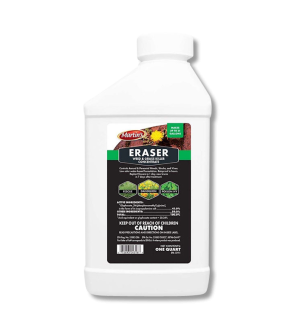Integrated Weed Management
Most Effective Products
Integrated Weed Management: How to Use IWM in Your Yard
This page is a professional guide on preventing weeds from developing in your yard through integrated weed management strategies. Follow this DIY guide and use the recommended products and tips to avoid discoloration, death, and other aesthetical damages to your desired foliage by learning about integrated weed management.
Controlling weeds is essential for any farmer, gardener, or homeowner that wants to produce a bountiful, and healthy plant. Besides the unsightly appearance, the main issue any plant owner will find with weeds in their yard is that they will compete for space, water, light, and nutrients with other plants or turf attempting to grow. Unfortunately, most weeds have a strong, and vigorous root system that easily overtakes desired foliage.
Weeds can also make your turf and ornamentals more susceptible to pests and diseases. They provide all the conditions pests need to thrive such as shade, food, and a place to hide. The loss of plants and possible increase of pests or diseases can cause homeowners to seek only chemical options. However, heavy reliance on only chemical options will not entirely be successful without integrated weed management practices.
Removing weeds without improving your plant management usually proves to be futile. With the information listed throughout this DIY guide, you can successfully learn about integrated weed management strategies to lessen and eventually fully control weed populations.
What is Integrated Weed Management
Integrated weed management (IWM) is simply the integration of a variety of weed control methods such as non-herbicide or cultural techniques pertaining to a specific treatment area in your property. It uses two or more weed control strategies such as cultural, physical, chemical, or biological methods in a balanced manner to avoid harmful damages to the environment and have the least impact on your finances.
In short, this isn't a replacement for herbicides, but simply a larger plan of control using multiple weed management practices.
Goal of Integrated Weed Management
The goal of integrated weed management is to prevent weeds from spreading and producing seeds so the weed population is lowered over time. This way there is no struggle for nutrients, water, space, or light between unwanted vegetation and desired foliage. This goal must be applied to all stages of desired foliage and not just when it is blooming.
Why is Integrated Weed Management Important
Most homeowners make the mistake in relying on a limited number of weed management tools, which results in uncontrollable weeds. The most common mistake that plant owners make is the repeated reliance on one type of herbicide for a weed population. While this does provide results it often leads to the unwanted plants to become resistant or reappear in the yard.
If conditions in your yard are not corrected, then the weed is most likely to reinfest your property. Within certain weed populations there are some weeds that can easily become resistant to herbicides. To avoid herbicide resistance, it would be best to rotate the group of herbicides and incorporate integrated weed management tactics.
Identify the Weed Before Using IWM

Before you can proceed with a treatment program and integrated weed management, you will need to properly identify which weed is infesting your yard. Misidentification of a weed can lead you to using the wrong herbicides and integrated weed management approach, costing you time and money.
There is a large variety of weeds that can develop in your yard or garden from grassy weeds, broadleaf weeds, perennial weeds, or annual weeds. As their name suggests, grassy weeds have long, slender grass blades that makes them hard to differentiate from turf. Broadleaf weeds can easily be identified from grassy weeds with their wide leaves and branching veins. Depending on the broadleaf weed, some weed species can produce flowers.
Annual weeds will only grow for a single season to produce seeds then perish in certain seasons. In the appropriate season for the weed the seeds from the previous infestation will grow helping the life cycle to continue.
Perennial weeds are a flowering type of weed that can grow from seeds or parts of other weeds such as stolons, roots, tuber, or other discarded part of the plant.
What Are the Methods of Integrated Weed Management
A successful integrated weed management uses multiple forms of weed control including prevention, mechanical control, biological control, cultural control, and chemical control. Its recommended you use at least two or more methods to control weeds on your property.
Before beginning any type of weed control program, it is best to wear the proper personal protective equipment (PPE) before using herbicides or handling weeds.
Prevention Weed Control

When it comes to weeds, prevention is the most effective weed control method for homeowners and professionals. Prevention stops weeds from growing or spreading before they can be established. Stopping weeds from infesting or spreading to other non-infested parts of the yard can be done through several tactics.
Examples of preventative weed control are as follows: cleaning used machinery to avoid bringing weed seeds into uncontaminated turf, garden, hay, and other areas, removing seeds from clothing or changing into new set of clothes before traveling into uninfested areas, inspecting seeds (hay, grass, feed, crop) quality, not moving soil or gravel with weeds in it, replenishing and amending soil, and limiting travel in weed infested areas.
Cultural Weed Control

An important part of weed management is cultural weed control. Simply cultural weed control is giving the greatest amount of success for growth and health of desired foliage to fight against weeds without tillage or chemicals. The success on this form of control depends on timely cultivations throughout the year.
Setting up successful growing conditions for desired plants and grasses is seen with the spacing of plant rows, mulching, timing of plant date, proper crop rotation, cover crops, maintaining soil fertility and irrigation, seed treatments, and the establishment of beneficial plants to set up good field and soil conditions.
Mechanical/Physical Weed Control

In mechanical or physical weed control methods, you are using physical forces to control weeds. This is done with either a weed eater, mower, backhoe, hand hoeing, tillage, mulching, hand pulling, and other mechanical or physical efforts.
This disturbs weed growth, slowing the rate at which the currently established weeds are able to grow to seed. This is also done to help make the ground more habitable for reseeding and planting of previously disturbed sites.
Biological Weed Control

Biological weed control involves the use of natural living organisms or bioagents such as weed eating insects, pathogens, competitive plants, and livestock grazing patterns to reduce the health and reproductive abilities of certain weeds.
Some insects can be used to control certain weed species, but care should be taken to ensure an insect population does not increase out of control. With biological weed control it is not possible to eliminate all weeds, but reduce the population until it is controllable.
This method is not useful for all weeds, but has shown to be the most effective for non-native weed species. Typically, most common biological control for weed management use the manipulation of livestock grazing patterns or release of certain weed/plant eating insects such as snails in problematic areas. If neither of these options are performed, then most homeowners avoid the use of certain materials that eliminate desired insects.
Chemical Weed Control

Chemical weed control is the use of herbicides to kill established weeds or control their germination. Based on the time of application, herbicides are classified as pre-emergent or post-emergent; and depending on how the herbicide moves throughout the plant are systemic or non-systemic (contact).
Before using any herbicide, check the product label to learn how they are used and how they function. Learn more about herbicide classification according to their mechanism and how they are used by following the associated links listed below:
Selective Herbicides: Chemicals that eliminate labeled grassy or broadleaf weeds without harming other types of foliage. For selective weed control, we recommend Fahrenheit Herbicide which is a successful post-emergent product that's used to treat over 100 weed species in warm-seasoned turf. When applied according to the product label instructions, this herbicide selectively controls annual and perennial broadleaf weeds and grasses.
Non-Selective Herbicide: Chemicals that will kill or damage all plants that come into contact with. Most of the time these type of herbicides are used when the application site is being used for construction or within commercial areas with parking lots or residential driveways.
A powerful non-selective herbicide we recommend is Eraser 41% Glyphosate. Eraser 41% Glyphosate is a emulsifiable concentrate that ceases certain proteins needed for plant growth through the active ingredient glyphosate 41%.
Systemic Herbicide: Chemical product formulated to be absorbed or move from the treated part of the weed then throughout the plant to their sites of physiological action. Complete coverage is not required with systemic herbicides, but a uniform application guarantees more success. These herbicides are recommended when trying to eliminate regenerative weeds with large taproots, like dandelions.
MSM Turf is a water dispersible granule that controls broadleaf and grassy weeds through the active ingredient metsulfuron methyl 60%. Once applied it will systemically travel by absorbing into the weeds surface and roots then block cell division to prevent plant growth.
Contact Herbicide: Unlike systemic herbicides, a contact herbicide only eliminates the weed or parts of the unwanted foliage that come into contact with it. Generally, these type of herbicides are used when a particular weed needs to be eliminated or a weed in specific area needs to be removed.
For a contact herbicide, we recommend using Eraser 41% Glyphosate which contains the active ingredient glyphosate 41% helping it to quickly kill any plant it is applied too. This product is often used to control weeds in specific areas like in cement cracks and crevices. For precise control, it would be best to use a spot treatment method in a handheld pump sprayer.
Post-Emergent Herbicide: Post-emergent means that it will eliminate weeds that have already developed and emerged from the ground. The success of post-emergent herbicides is dependent on the time of year and location. It can take multiple reapplications to completely control the infestation. Our go to post-emergent product is MSM Turf, which can control weeds at any stage of growth, however, has the best results when applied to young, actively growing weeds. Application may be made at any time of the year, except when the ground is frozen.
Pre-Emergent Herbicide: Pre-emergent specifically targets weed seeds underneath the soil and stop them from growing. Generally, they are most effective when applied before the weeds emerge from the soil. An example is Barricade Granular Pre-Emergent Herbicide, it is a granular pre-emergent herbicide that can prevent various grassy and broadleaf weeds before they emerge in turf, landscape ornamentals, and established perennials and wildflower plantings.
Key Takeaways
When to Use Integrated Weed Management
- A healthy lawn should implement integrated weed management practices at the beginning and throughout the plants growing season to best fight against troublesome weeds.
What is the Difference Between Weed Control and Weed Management
- Weed control is the process of eliminating weeds that have already become established while weed management, also known as IWM, refers to any control method that aims to prevent weeds from being established.
What is the First Thing To Do In Integrated Weed Management?
- Before taking any integrated weed management action, you will first need to identify the weed to ensure the proper steps and herbicides are used.














































































































































































































































































































































































































































































































































